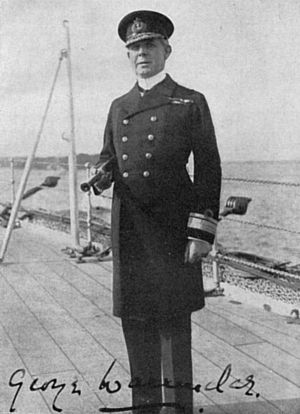Sir George Warrender, 7th Baronet facts for kids
Quick facts for kids
George Warrender
|
|
|---|---|

George Warrender
|
|
| Born | 3 July 1860 Edinburgh, Midlothian, Scotland, UK |
| Died | 8 January 1917 (aged 56) London, England, UK |
| Allegiance | |
| Service/ |
|
| Years of service | 1873–1916 |
| Rank | Vice-Admiral |
| Commands held | East India Squadron 2nd Battle Squadron Plymouth Command |
| Battles/wars | |
| Awards | Knight Commander of the Order of the Bath Knight Commander of the Royal Victorian Order |
Vice-Admiral Sir George Warrender (born July 31, 1860 – died January 8, 1917) was an important officer in the Royal Navy. He served during a very important time, including World War I.
Contents
George Warrender was born in Edinburgh, Scotland. He was one of six children. He joined the navy as a cadet in 1873 when he was just 13 years old. He trained at Dartmouth.
In 1879, he served as a midshipman (a junior officer) during the Zulu War. He was part of a group of sailors who helped relieve the Siege of Eshowe. He also fought in the Battle of Gingindlovu. For his bravery, he received the South Africa medal.
In 1880, he became a Lieutenant. He became very good at gunnery, which is the use of naval guns. He served on several ships, including the cruiser HMS Amphion. In 1893, he was promoted to commander. From 1896 to 1899, he commanded the royal yacht, HMY Victoria and Albert.
Leading Ships and Squadrons
George Warrender became a captain in 1899. He fought in the Boxer Rebellion in China in 1900. He was the flag captain (the captain of the admiral's ship) for Rear-Admiral Sir James Bruce on HMS Barfleur.
He later commanded HMS Lancaster and HMS Carnarvon in the Mediterranean Sea. In 1908, he became a Rear Admiral. He then led the East Indies Station from 1907 to 1909.
From 1910 to 1912, he commanded the Second Cruiser Squadron. In 1912, he took charge of the 2nd Battle Squadron. His flagship (his main ship) was the new battleship HMS King George V. He was promoted to Vice-Admiral in 1913.
The 1914 Kiel Visit
In June 1914, just before World War I began, Warrender's squadron visited Kiel, a German naval port. This was during the annual regatta, a big sailing event. The German Kaiser (Emperor) Wilhelm II and top German admirals were there.
The visit was meant to show off the modern British ships and let the British see the German fleet. During the visit, news arrived that Archduke Franz Ferdinand of Austria had been assassinated. This event would soon lead to World War I.
Warrender's final message to the Germans was, Friends in the past, friends forever.
A German Officer's View
A German officer named Lieutenant George von Hase was assigned to help Warrender. Hase later wrote about Warrender. He described Warrender as a good-looking man with blue eyes. He seemed about 50, with graying hair, but was still very energetic.
Warrender was popular with his sailors because he cared about them. He was also quite deaf, which sometimes made conversations difficult, especially in noisy places. He was known to be a good tennis player and golfer.
Warrender's wife also came on the visit. She stayed on a ship that was the center of social events. There were many parties and sports competitions between British and German teams. The Germans won most sports, except football. Hase noticed that many British sailors were quite young or older.
Warrender invited German officers to visit his ships. At first, the German Admiral Ingenohl said no, because he couldn't show many parts of his ships. Warrender understood, and visits were arranged. British officers could only see older German battleships. Important parts of British ships were covered up. However, one British officer showed a German officer almost all of his ship, except for a secret "firing director."
On June 28, the news of Franz Ferdinand's assassination arrived. Warrender warned that many countries might soon go to war. Social events were canceled, but the regatta finished. The next day, the Kaiser left for Vienna.
Warrender had lunch with German admirals on his ship. They were shown how the main guns worked. Later, British sailors held a party for their German friends. Warrender gave a speech about friendship between the two nations.
Warrender also discussed how submarines might change naval warfare. He believed that in the future, it would be impossible to block enemy ports closely.
Serving in World War I
Soon after the Kiel visit, Warrender briefly commanded the Grand Fleet. This was when war was expected to start.
Warrender was seen as a good admiral in peacetime. However, his reputation suffered during the war. His squadron was known for being very good at gunnery. Some people thought he was calm, while others felt he lacked new ideas.
In October 1914, one of his battleships, HMS Audacious, sank after hitting a mine during gunnery practice.
Later, Warrender commanded a British force that tried to stop Admiral Hipper after Hipper's raid on Scarborough. Hipper's ships escaped, even though Warrender's force was stronger. The head of the navy, Fisher, wanted Warrender replaced. However, Warrender was a friend of Admiral John Jellicoe, who commanded the Grand Fleet. Jellicoe kept Warrender in his job because of his experience.
Warrender's deafness was getting worse. He was replaced in December 1915. In March 1916, he became the Commander-in-Chief at Plymouth. But in December 1916, he asked to retire because of his poor health.
Sir George Warrender died in January 1917.
Family Life
One of George Warrender's sisters, Alice Warrender, created the Hawthornden Prize, an award for writers.
He married Lady Ethel Maud Ashley Cooper in 1894. They had three children: Victor Alexander George Anthony Warrender, Harold John Warrender, and Violet Helen Marie Warrender.


